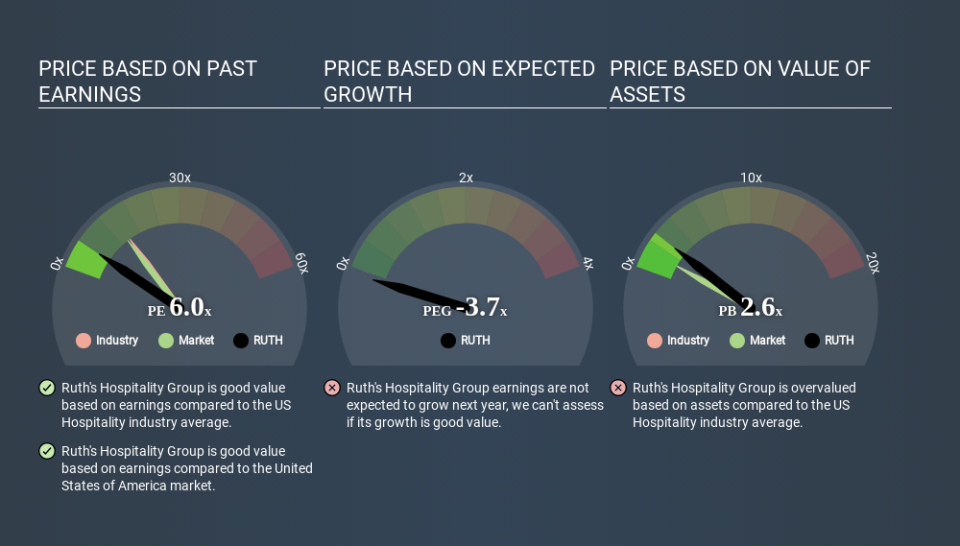What Is Ruth's Hospitality Group's (NASDAQ:RUTH) P/E Ratio After Its Share Price Tanked?

To the annoyance of some shareholders, Ruth's Hospitality Group (NASDAQ:RUTH) shares are down a considerable 30% in the last month. And that drop will have no doubt have some shareholders concerned that the 66% share price decline, over the last year, has turned them into bagholders. For those wondering, a bagholder is someone who keeps holding a losing stock indefinitely, without taking the time to consider its prospects carefully, going forward.
Assuming nothing else has changed, a lower share price makes a stock more attractive to potential buyers. In the long term, share prices tend to follow earnings per share, but in the short term prices bounce around in response to short term factors (which are not always obvious). The implication here is that long term investors have an opportunity when expectations of a company are too low. One way to gauge market expectations of a stock is to look at its Price to Earnings Ratio (PE Ratio). Investors have optimistic expectations of companies with higher P/E ratios, compared to companies with lower P/E ratios.
Check out our latest analysis for Ruth's Hospitality Group
Does Ruth's Hospitality Group Have A Relatively High Or Low P/E For Its Industry?
We can tell from its P/E ratio of 5.97 that sentiment around Ruth's Hospitality Group isn't particularly high. If you look at the image below, you can see Ruth's Hospitality Group has a lower P/E than the average (14.7) in the hospitality industry classification.
Ruth's Hospitality Group's P/E tells us that market participants think it will not fare as well as its peers in the same industry. Since the market seems unimpressed with Ruth's Hospitality Group, it's quite possible it could surprise on the upside. If you consider the stock interesting, further research is recommended. For example, I often monitor director buying and selling.
How Growth Rates Impact P/E Ratios
Generally speaking the rate of earnings growth has a profound impact on a company's P/E multiple. Earnings growth means that in the future the 'E' will be higher. Therefore, even if you pay a high multiple of earnings now, that multiple will become lower in the future. A lower P/E should indicate the stock is cheap relative to others -- and that may attract buyers.
Ruth's Hospitality Group's earnings per share grew by 3.9% in the last twelve months. And its annual EPS growth rate over 5 years is 14%.
Remember: P/E Ratios Don't Consider The Balance Sheet
The 'Price' in P/E reflects the market capitalization of the company. In other words, it does not consider any debt or cash that the company may have on the balance sheet. Theoretically, a business can improve its earnings (and produce a lower P/E in the future) by investing in growth. That means taking on debt (or spending its cash).
Spending on growth might be good or bad a few years later, but the point is that the P/E ratio does not account for the option (or lack thereof).
Is Debt Impacting Ruth's Hospitality Group's P/E?
Net debt totals 24% of Ruth's Hospitality Group's market cap. This could bring some additional risk, and reduce the number of investment options for management; worth remembering if you compare its P/E to businesses without debt.
The Bottom Line On Ruth's Hospitality Group's P/E Ratio
Ruth's Hospitality Group trades on a P/E ratio of 6.0, which is below the US market average of 14.0. The company does have a little debt, and EPS is moving in the right direction. The P/E ratio implies the market is cautious about longer term prospects. Given Ruth's Hospitality Group's P/E ratio has declined from 8.5 to 6.0 in the last month, we know for sure that the market is more worried about the business today, than it was back then. For those who prefer to invest with the flow of momentum, that might be a bad sign, but for deep value investors this stock might justify some research.
Investors should be looking to buy stocks that the market is wrong about. If it is underestimating a company, investors can make money by buying and holding the shares until the market corrects itself. So this free visual report on analyst forecasts could hold the key to an excellent investment decision.
But note: Ruth's Hospitality Group may not be the best stock to buy. So take a peek at this free list of interesting companies with strong recent earnings growth (and a P/E ratio below 20).
If you spot an error that warrants correction, please contact the editor at editorial-team@simplywallst.com. This article by Simply Wall St is general in nature. It does not constitute a recommendation to buy or sell any stock, and does not take account of your objectives, or your financial situation. Simply Wall St has no position in the stocks mentioned.
We aim to bring you long-term focused research analysis driven by fundamental data. Note that our analysis may not factor in the latest price-sensitive company announcements or qualitative material. Thank you for reading.

 Yahoo Finance
Yahoo Finance 
